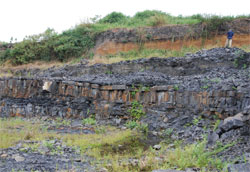We often speak in these pages about extinction events, and cite such examples as the Cretaceous-Tertiary event some 65.5 million years ago, when the mass extinction of dinosaurs and numerous animal and plant species occurred. Whether caused by an incoming asteroid or comet or through a series of catastrophes including volcanic eruptions (the Deccan traps), the K-T event is the classic reminder of the perils that confront life. But perhaps the largest extinction event of all was the so-called ‘oxygen catastrophe,’ an environmental change that caused oxygen to become widely available in the atmosphere and shallow ocean water.

The oxygen catastrophe occurred around 2.4 billion years ago and doomed the bulk of Earth’s anaerobic inhabitants. Astrobiologists are fascinated with how life adapts to changing environments, so we’d like to learn much more about how these events proceeded. Now comes news of fossils in black shale formations in Africa that are apparently 200 million years older than our previous examples of multicellular life. The team studying the fossils, led by Abderrazak El Albani (University of Poitiers), found them in the Francevillian Basin in the west African nation of Gabon, where they located more than 250 specimens, all of them dating to approximately 2.1 billion years ago. The biological origin of these fossils has been confirmed and their complex structures deemed to indicate coordinated growth between cells.
Image: Virtual reconstruction (by microtomography) of the external morphology (left) and internal (right) of a specimen from the site in Gabon. Image copyright CNRS Photo Library/A. El Albani & A. Mazurier.
The work is covered in Nature this week (see below) and written up at TheScientist.com, from which this quote discussing the fossils’ complexity and possible cell to cell signaling:
Specifically, the fossils display scalloped edges with radiating slits, and many have a central structure, not unlike the overall structure of a jellyfish medusa. “This organism, in my opinion, was something very light, very gentle, very soft,” El Albani speculated. Given the ubiquity of the radial structures among the highly diverse specimens, “I am sure that this radial fabric has some functionality for these specimens,” he said, possibly for movement or fixation to the sediment, but “we have a lot of work [to do]” to determine what that function truly was. Still, the complexity and organization of their structure “shows clearly that [these organisms were] multicellular,” he insisted.

The organisms are thought to have lived in a marine environment of shallow water 20 to 30 meters deep. Paleontologist Philip Donoghue (University of Bristol), who wrote an accompanying analysis of this work in Nature, notes that the fossils appeared within a few million years of the oxygen catastrophe, which he calls the Great Oxidation Event. Studying how organisms like this reacted to increasingly available oxygen is made more difficult because most of the rocks from the period have been destroyed. Donoghue adds the caution that we shouldn’t necessarily view these fossils as the ancestors of all multicellular life. Quoting again from TheScientist.com:
Multicellularity hasn’t evolved just once; it’s evolved almost 20 times even amongst living lineages,” [Donoghue] said. “This is probably one of a great number of extinct lineages that experimented with [increased] organismal complexity.”
Image: The fossil site near Franceville, Gabon. Image copyright CNRS Photo Library/F. Ossa Ossa.
From a broader perspective, we keep finding evidence of life’s gritty persistence in the face of seemingly fatal environmental changes, all of which should give us pause in evaluating habitable environments on other worlds. Supposing life got a start, the receding seas of Mars or the ice-bound oceans of Europa may still nurture robust survivors. We’ve learned, too, that as far out as the Kuiper Belt, objects with sub-surface water may be plentiful, and it’s not impossible that there may be some kind of simple life forms all the way from the cloud tops of Venus to the icy realm of Triton and beyond.
The paper is El Albani et al., “Large colonial organisms with coordinated growth in oxygenated environments 2.1 Gyr ago,” Nature 466 (1 July 2010), pp. 100-104 (abstract). Dongohue’s analysis of the work is Donoghue and Antcliffe, “Early Life: Origins of Multicellularity,” Nature 466 (1 July 2010), published online (thanks to Centauri Dreams readers Adam Crowl and Zen Blade for the pointer). A news release from the University of Poitiers is available.



Gritty persistence. What a good way of putting it. Life has persisted, inspite of ‘Medea’ and her infanticidal efforts. I just hope it survives the present mass extinction as well as it did in the past.
You know where on Earth there’s almost no life whatsoever, not even bacterial?
The high Antarctic plateau. Too cold, too dry. Life has a few scrabbly toeholds around the edges of the continent and in odd places like subglacial lakes, but 99.9% of the Antarctic plateau is as sterile as a good saline solution.
It’s not the only place, either. Soil samples taken from the interior of the Atacama desert show soils that are utterly sterile — you can’t culture bacteria from them, they don’t produce any byproducts of decomposition or metabolism, microscopic examination shows no cells or spores, and they test negative for DNA. To the best of our ability to tell, the central Atacama is as dead as the surface of the Moon.
Note that the Antarctic plateau was crawling with life as recently as the Eocene, while the Atacama was a high savanna watered by tropical monsoons as recently as the Pliocene. But then up came the Andes and wham: the Atacama was sterilized as efficiently as if the Sun had gone nova.
So, color me skeptical. I think a lot of people are making an unjustified leap from “life is turning up in places we never thought of” to “zomg! life is unstoppable and unkillable!”
Doug M.
This organism looks like a progenitor to the Ediacara fauna or Vendian fauna.
Most life,the kind we are familiar with anyway,requires the presence of liquid water.
The frequency of enviroments with liquid water is unknown but may in fact be quite numerous as observations of Europa and other places have indicated.
Color me skeptical that multicellular life evolved seperately many times. Is this generally accepted fact? If it is so, then one more hurdle to the proliferation of multicellular organisms in the galaxy has been breached. But I think not…Yet at least.
Doug M, the Atacama is not as sterile as you suggest, although it is pretty barren and about as lifeless a place as one can find on Earth. However, bacteria and fungi can be found actively growing there, even in the hyper arid zones, see:
doi:10.1128/AEM.01305-06
Hello, philw1776,
When I was in high school, ages ago, the curriculae went biology, then chemistry, then physics. It struck me that was the wrong ordering, and should have been reversed. Physics acknowledges the fundamental laws, chemistry is a refinement and portion thereof, and biology is a minor aspect of chemistry.
The physical laws are always in place. They seem to be uniform throughout the observable universe. So too is its chemistry. If conditions permit, there is every reason life should attempt to re-assert itself, whether formed at the planetary surface, or brought on by panspermia.
Granted the acknowledged previous extinctions, it does seem remarkable we are here to discuss this. But here we are. And part of us manifests wonder, and awe. We seek where we came from… the cosmos itself.
philw1776, a place to start:
http://en.wikipedia.org/wiki/Multicellular_organism
I recall hearing this as a biology major, but I’ve forgotten much of it in the intervening 30+ years, and of course much more has been discovered in that time.
“Color me skeptical that multicellular life evolved seperately many times. Is this generally accepted fact?”
Yes, it is. Something between half a dozen and twenty different times, depending on how generous your definition of “multicellular” is (i.e., do biofilms count? What about bacterial mats? What if they show repulsive chemotaxis and internal specialization?)
Plants, animals and fungi all seem to have evolved multicellularity independently. In fact, within the plant kingdom alone, it seems to have evolved at least three times — kelp, for instance, are huge plants, big as trees, and yet they seem to have been a completely independent development from unicellular brown algae.
Then there are slime molds, stromatolites, and a host of obscure but valid colonial prokaryotes.
So, yes — it is generally accepted fact. If you want more details, google “multicellular evolution” and click around.
@Doug K., wow! I did not know that. Thank you.
Doug M.
I don’t remember who said it, but I think the best guideline for thinking about the universe and about life, especially, is “Not only is it queerer than we suppose, it is queerer than we can suppose.”
I have always liked pulp science fiction from before the 1940’s for just that reason. Nothing was too outrageous or downright fantastical for those writers. Yes, the writing was often terrible, but it was rich in imagination. In one very early novel radium is used to ressurect the dead.
Sure the actual work of science involves finding out that the fantastic is, well, fantastic, but we live in a world where a large percentage of commerce, communication, navigation and social life in the western world can be brought down by solar flares.
Jellyfish-like things in the upper reaches of a gas giant don’t seem especially far-fetched in that light.
Whoops, I almost forgot about _Volvox_. Sometime back in the Mesozoic, some unicellular green algae learned how to join together to form little colonial balls that could swim around looking for nutrients and light. They’re now completely and truly multicellular — most of the algae in a Volvox body are somatic cells, and only a few germ cells reproduce.
Also worth googling: watermelon snow. On one hand, it’s a plant — not a bacterium, but an actual eukaryotic plant — that lives on and inside snow, not just tolerating but needing subzero temperatures. OTOH, it has a pretty strict lower temperature limit — below about zero degrees Fahrenheit, it goes inactive and can no longer metabolize or reproduce. (Which is why it’s not found in the interior of Antarctica.)
Doug M
I think what needs to be pointed out here is that if multicellularity (in one form or another) has existed for 2 billion years…
Do multicellular organisms survive for long, and how easily do they progress to large and more complex organisms. Unfortunately, the fossil record is not particularly great 1 billion or 2 billion years ago. However, we know that there were not many large organisms until considerably later.
Some may argue that this limitation is a result of atmospheric conditions, and I would not disagree. However, there are interesting questions regarding the time required during each “phase” of planetary/biological evolution.
-Zen Blade
Mining ancient ores for clues to early life
Montreal, Canada (SPX) Dec 11, 2012 – An analysis of sulfide ore deposits from one of the world’s richest base-metal mines confirms that oxygen levels were extremely low on Earth 2.7 billion years ago, but also shows that microbes were actively feeding on sulfate in the ocean and influencing seawater chemistry during that geological time period.
The research, reported by a team of Canadian and U.S. scientists in Nature Geoscience … more here:
http://www.spacedaily.com/reports/Mining_ancient_ores_for_clues_to_early_life_999.html